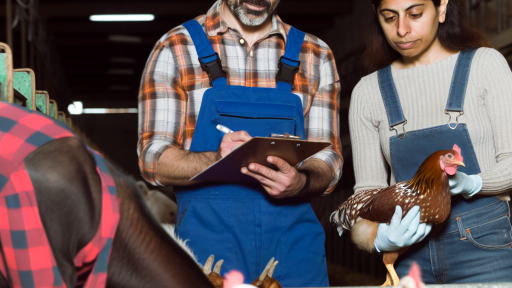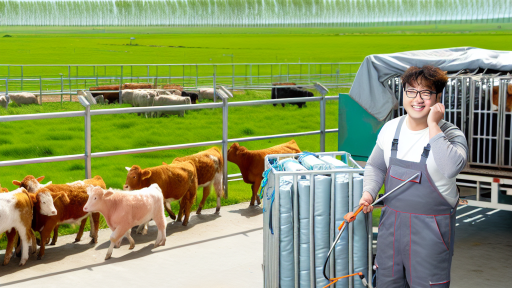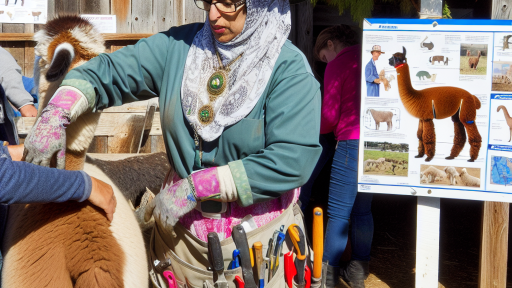Introduction to Breeding Cycles and Their Importance in Farming
Breeding cycles are crucial for achieving efficiency in farming.
They determine how quickly livestock can reproduce.
Farmers must optimize these cycles to enhance productivity.
Understanding Breeding Cycles
A breeding cycle is the period from conception to weaning.
This cycle greatly influences the sustainability of the farm.
In livestock farming, timing plays a vital role.
Properly timed breeding can maximize offspring production.
The Impacts of Efficiency
Efficient breeding leads to a higher yield of products.
This includes milk, meat, and other animal products.
Moreover, it contributes to better resource management.
Farmers benefit from reduced costs and increased profitability.
Components of Successful Breeding
Several factors affect breeding efficiency.
- Selection of breeding stock is key.
- Health management of animals impacts reproduction.
- Nutrition directly influences breeding outcomes.
- Environmental conditions also play a significant role.
Addressing these components can enhance breeding success.
Implementing Strategies for Improvement
Farmers can implement several strategies to improve breeding cycles.
Regular veterinary check-ups ensure animal health.
Transform Your Agribusiness
Unlock your farm's potential with expert advice tailored to your needs. Get actionable steps that drive real results.
Get StartedThis practice helps identify reproductive issues early.
Additionally, using genetic testing can streamline selection.
Feeding a balanced diet is critical for optimal health.
The Role of Technology
Modern technology supports efficient breeding practices.
Farm management software helps track breeding cycles.
Moreover, genetic engineering offers new solutions.
These tools allow farmers to make informed decisions.
Understanding the Biological Aspects of Breeding for Optimal Results
Fundamentals of Genetics
Genetics plays a crucial role in breeding efficiency.
Understanding inheritance patterns can enhance outcomes.
Additionally, knowing allele variations aids in selection.
Farmers should focus on genetic diversity.
This diversity can improve resilience in crops.
Breeding Cycle Timing
Timing significantly impacts breeding success.
For instance, monitor weather patterns for planting times.
Moreover, synchronize breeding cycles with environmental conditions.
By doing so, yield potential can increase.
Effective timing also ensures optimal pollination.
Nutritional Requirements
Nutritional needs vary across breeding stages.
Understanding these requirements optimizes health.
During vegetative phases, adequate nitrogen is essential.
Conversely, phosphorus boosts root development.
Vitamins and minerals support overall plant vigor.
Pest and Disease Management
Pest management is vital for successful breeding.
Integrating pest-resistant varieties reduces crop loss.
Showcase Your Farming Business
Publish your professional farming services profile on our blog for a one-time fee of $200 and reach a dedicated audience of farmers and agribusiness owners.
Publish Your ProfileRegular monitoring identifies vulnerable plants early.
Additionally, adopt organic practices to lower chemical use.
Healthy plants are more resilient to diseases.
Commitment to Research and Development
Investing in research enhances breeding programs.
Collaboration with local agricultural institutions is beneficial.
Furthermore, staying updated on scientific advances aids strategies.
Using technology in breeding can streamline processes.
Embracing innovation keeps farms competitive.
Evaluating Current Breeding Practices
Understanding Current Techniques
Breeding practices vary significantly across different species and industries.
Farmers frequently rely on traditional methods for breeding crops and livestock.
These techniques may include selective breeding and hybridization.
However, such methods can have limitations concerning efficiency.
It is essential to assess the efficacy of these techniques critically.
Identifying Challenges
Several challenges hinder optimal breeding results.
For instance, inbreeding can lead to health issues in animal populations.
Additionally, limited genetic diversity affects crop resilience.
Pest-resistant strains often see reduced effectiveness over time.
As a result, farmers must adapt to overcoming these challenges.
Assessing Outcomes
Evaluating breeding outcomes helps determine efficiency levels.
Key performance indicators include yield, growth rate, and disease resistance.
Regular monitoring can uncover trends and areas needing improvement.
Farmers should analyze data to make informed breeding decisions.
This process allows for refining methods over time.
Exploring Innovations
Recent advancements in technology provide new opportunities for breeding efficiency.
Genetic engineering opens pathways for targeted traits in crops and animals.
Moreover, genome sequencing offers detailed insights into genetic material.
As such, integrating these innovations into current practices may revolutionize breeding cycles.
In turn, this could enhance overall agricultural productivity.
Find Out More: Optimizing Water Quality in Fish Farming Environments
Implementing Genetic Selection Techniques to Enhance Breeding Efficiency
Importance of Genetic Selection
Genetic selection significantly impacts breeding cycles.
This technique optimizes desirable traits in offspring.
By selecting superior genetics, farmers can improve yield quality.
Moreover, it enhances livestock health and performance.
Methods of Genetic Selection
Various methods exist for effective genetic selection.
These include phenotypic selection and genomic selection.
Phenotypic selection emphasizes observable traits in individuals.
Genomic selection utilizes DNA information for predicted performance.
Advantages of Genetic Selection Techniques
Employing genetic selection techniques offers numerous advantages.
- Increased efficiency in breeding cycles.
- Reduction in generation intervals.
- Improved uniformity of offspring.
Additionally, it helps reduce breeding costs over time.
Challenges in Implementing Genetic Selection
However, challenges can arise during implementation.
Showcase Your Farming Business
Publish your professional farming services profile on our blog for a one-time fee of $200 and reach a dedicated audience of farmers and agribusiness owners.
Publish Your ProfileAccess to quality genetic resources may be limited.
Furthermore, there might be a lack of adequate training.
Farmers might also face difficulties in interpreting genomic data.
Future Trends in Genetic Selection
The future holds promise for genetic selection advancements.
Emerging technologies continue to enhance accuracy.
Breeders will increasingly adopt integrated approaches.
These advancements will ensure more efficient breeding cycles.
Explore Further: Ensuring Animal Welfare During Transportation
Utilizing Technology
Data Analysis in Breeding
Data analysis enhances breeding decisions significantly.
It allows breeders to track genetic traits over generations.
Additionally, it helps in identifying optimal pairings for breeding.
Tools like gene mapping and genomic selection come into play.
These tools provide insights into the genetic potential of candidates.
Moreover, they increase the chances of desirable traits in offspring.
Software Solutions for Breeding Management
Various software platforms offer innovative breeding solutions.
These solutions simplify the management of breeding cycles.
For instance, Breeding Insight helps in planning and analysis.
It enables users to visualize and simulate breeding scenarios.
Furthermore, FarmLogs allows tracking of plant health and yield.
Such platforms ensure data is organized and easily accessible.
Integrating IoT in Breeding Programs
Internet of Things (IoT) devices play a crucial role in modern breeding.
They collect real-time data from the field environment.
This data aids in understanding how conditions affect breeding outcomes.
Wireless sensors monitor factors like temperature and humidity efficiently.
As a result, breeders can make timely adjustments to their practices.
Machine Learning Applications
Machine learning algorithms analyze vast amounts of data.
These algorithms identify patterns that inform breeding strategies.
Additionally, they enable predictive modeling for future outcomes.
Breeders can optimize their choices based on evidence rather than guesswork.
Such applications lead to increased efficiency in breeding cycles.
Real-Life Success Stories
Many organizations have successfully adopted technology in breeding.
For instance, AgroTech uses data analytics to optimize yield.
Through advanced software, they have increased crop productivity by 30%.
Similarly, GrowSmart integrates IoT to monitor soil health effectively.
Such innovations demonstrate the power of technology in agriculture.
Gain More Insights: Insulation Techniques For Livestock Facilities
Cost-Benefit Analysis: Economic Implications of Optimizing Breeding Cycles
Understanding the Economic Landscape
Optimizing breeding cycles significantly enhances productivity.
Farmers can increase yields while decreasing costs.
This approach directly impacts the overall profit margins.
Moreover, careful planning leads to reduced waste.
Showcase Your Farming Business
Publish your professional farming services profile on our blog for a one-time fee of $200 and reach a dedicated audience of farmers and agribusiness owners.
Publish Your ProfileEfficiencies in breeding allow for quicker turnaround times.
Identifying Costs and Benefits
Investing in technology is vital for optimizing breeding cycles.
Initial costs may appear high, but long-term savings are substantial.
For example, automated systems streamline operations and decrease labor costs.
Additionally, healthy breeding stock reduces veterinary expenses.
Farmers must consider both tangible and intangible benefits.
Evaluating Profit Margins
Higher efficiencies directly correlate with improved profit margins.
When farmers optimize breeding cycles, they can sell more products.
Increased sales lead to greater revenue streams.
Furthermore, cost savings enhance financial sustainability.
Farmers must continuously monitor their profit margins.
Investment in Research and Development
Investing in research is crucial for innovation in breeding methods.
New techniques can lead to healthier and more productive livestock.
Many successful farmers advocate for ongoing education in breeding practices.
Successfully implemented innovations can yield significant economic returns.
Case Studies of Success
Numerous farms demonstrate the benefits of optimized breeding cycles.
The Bennett Family Farm reported a 30% decrease in costs following upgrades.
They invested in data analytics to monitor breeding effectiveness.
Similarly, Green Valley Farms noted higher quality crops through improved methods.
These examples illustrate the economic advantages of conscientious breeding practices.
Long-term Sustainability
Optimizing breeding cycles contributes to long-term farming sustainability.
Farmers who adopt these methods are better prepared for future challenges.
Sustainable practices enhance soil health and biodiversity.
Ultimately, a balanced approach benefits the entire agricultural industry.
Farmers should prioritize sustainable methods to ensure lasting prosperity.
See Related Content: Integrating Exotic Livestock into Your Farm System

Sustainable Practices in Breeding: Balancing Efficiency and Environmental Impact
The Importance of Sustainability in Breeding
Sustainability is a vital consideration in modern breeding practices.
It ensures that breeding strategies maintain ecological health.
Moreover, it contributes to the longevity of breeding programs.
Integrating Eco-Friendly Methods
Implementing eco-friendly methods enhances breeding cycles.
These methods reduce reliance on synthetic chemicals.
Organic fertilizers can improve soil and crop health.
Additionally, crop rotation promotes biodiversity.
Resource Conservation Strategies
Efficient use of water is crucial in breeding practices.
Methods like drip irrigation minimize water wastage.
Furthermore, rainwater harvesting boosts resource availability.
Energy Efficiency in Breeding Operations
Breeding operations should prioritize energy efficiency.
Using renewable energy sources reduces carbon footprints.
Solar panels and wind turbines are viable options.
Economic Benefits of Sustainable Practices
Sustainable practices can lead to cost savings.
Showcase Your Farming Business
Publish your professional farming services profile on our blog for a one-time fee of $200 and reach a dedicated audience of farmers and agribusiness owners.
Publish Your ProfileLess chemical use translates to lower input costs.
Moreover, producing healthy crops increases marketability.
Stakeholder Engagement in Breeding
Engaging stakeholders fosters a collective approach to sustainability.
Farmers, researchers, and consumers can collaborate effectively.
Education on sustainable practices enhances community involvement.
Monitoring and Measuring Impact
Monitoring practices help measure sustainability outcomes.
Utilizing indicators allows for effective evaluation.
Continuous assessment enables adaptation of strategies.
Case Studies in Sustainable Breeding
Case studies highlight successful sustainable practices.
For instance, GreenSprout Farms adopted organic breeding.
This practice improved yield while preserving soil health.
Furthermore, EcoBreed Initiative utilized native species effectively.
Challenges to Sustainable Breeding Practices
Barriers still exist in implementing sustainable methods.
For instance, initial costs can deter adoption.
Additionally, lack of knowledge in new techniques is common.
Future Directions for Sustainable Breeding
The future of breeding lies in sustainability.
Innovations in technology can further enhance practices.
Ultimately, sustainable breeding supports food security.
Case Studies: Successful Implementation of Optimized Breeding Cycles in Agriculture
Introduction to Case Studies
Optimized breeding cycles can greatly enhance agricultural production.
Several case studies illustrate this principle effectively.
Case Study: Greenfield Farms
Greenfield Farms applied advanced breeding techniques to boost crop yields.
They used genetic information to select the best parent plants.
This method reduced the breeding cycle by 25%.
Higher yields followed, demonstrating the cycle’s efficiency.
Case Study: Evergreen Horticulture
They collected extensive data on plant traits and environmental conditions.
This allowed for precise selections in breeding.
As a result, their flowering plants matured faster than previous seasons.
Case Study: Sunny Valley Cooperative
Sunny Valley Cooperative focused on collaborative breeding practices.
Farmers shared their successful breeding strategies within the community.
They reduced duplication of efforts and enhanced overall productivity.
This teamwork resulted in superior crop varieties reaching the market.
Insights on Optimized Breeding Cycles
These case studies highlight important strategies in optimizing breeding cycles.
They show that innovative techniques can lead to increased efficiency.
Moreover, teamwork and data-driven approaches proved beneficial.
These insights can help other farms improve their breeding processes.
Future Trends in Breeding: Genetic Engineering and Biotechnology Advances
Introduction to Genetic Engineering
Genetic engineering revolutionizes traditional breeding practices.
This technology allows precise modifications of an organism’s DNA.
Consequently, it enhances desirable traits more efficiently.
Advancements in Biotechnology
Biotechnology continues to push boundaries in agriculture.
Showcase Your Farming Business
Publish your professional farming services profile on our blog for a one-time fee of $200 and reach a dedicated audience of farmers and agribusiness owners.
Publish Your ProfileInnovative tools enable rapid crop improvement strategies.
For instance, CRISPR technology provides targeted gene editing.
This efficiency decreases the time required for breeding cycles.
Impact on Crop Yields
Genetic modifications lead to higher crop yields.
These innovations can address global food security challenges.
Moreover, biotech crops exhibit better resistance to pests.
Hence, farmers can reduce chemical pesticide usage.
Ethical Considerations
Ethical debates surround the use of genetic engineering.
Opponents raise concerns about potential long-term impacts.
Nevertheless, proponents argue for the benefits of innovation.
Careful regulations can ensure responsible application of technologies.
Future Directions
Looking ahead, further advancements in biotechnology seem likely.
Research into gene editing will continue to expand.
Also, integrating artificial intelligence can optimize breeding programs.
Consequently, these changes will enhance agricultural productivity.
Additional Resources
People – UF/IFAS Animal Sciences – University of Florida, Institute of …




